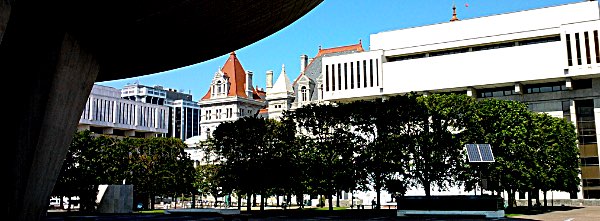- By New York State Comptroller's Office
- Business & Technology
 Print
Print 
The $175.1 billion State Fiscal Year (SFY) 2019-20 Executive Budget advances several measures to reduce the financial risks posed to New York by unpredictable tax revenues and federal funding, according to a report released Wednesday by State Comptroller Thomas P. DiNapoli. Still, larger-than-expected declines in current fiscal year tax collections leave uncertainty that may not be fully clarified before the April 1 start of the new fiscal year.
State tax collections for the month of January were $2.3 billion below the Division of Budget's (DOB) initial Executive Budget projections. DOB has reduced estimates of tax receipts for the current and next fiscal years by $5.7 billion since release of the November update of the Financial Plan.
"As lawmakers craft next year's state budget, they are negotiating under the threat of slower economic growth, volatile financial markets and continuing revenue uncertainty," said DiNapoli. "Decisions on the new budget demand an exceptionally high degree of caution, and I encourage the Governor and Legislature to bolster the state's rainy day funds to better prepare for future fiscal challenges."
The budget anticipates depositing $488 million from previously unallocated monetary settlement funds into the Rainy Day Reserve Fund in the current and next fiscal years with the caveat "if fiscal conditions permit." Total General Fund reserves are projected to be $6.5 billion at the end of the current fiscal year before declining by approximately $1.5 billion in the coming year and by more than $2.5 billion in succeeding years as resources are spent for various purposes. The state's last deposit to the rainy day reserves was in 2015.
The Financial Plan projects tax receipts will increase 7.8 percent in SFY 2019-20. Proposed statutory actions are expected to result in net revenue gains of just over $1 billion in the coming fiscal year. The bulk of this increase flows from a proposal to extend the top personal income tax rate of 8.82 percent, currently scheduled to expire on Dec. 31, through 2024. Compared to previous, shorter extensions of the higher rate, the five-year extension would provide additional revenue stability.
DiNapoli's report also finds:
- Out-year budget gaps projected for the three years starting with SFY 2020-21 average $4.8 billion annually, including the effect of current proposals but before potential gap-closing actions;
- The budget is expected to use nearly $7.6 billion in temporary or non-recurring resources in SFY 2019-20, largely from extending the top rate on personal income tax and pre-paying debt service. As part of its response to the shortfall in SFY 2018-19 receipts, DOB also plans to use more than $1.5 billion in resources of this nature during the current fiscal year, including $491 million in monetary settlement proceeds going to General Fund relief and $310 million in accumulated fund balances;
- Various aspects of the budget raise concerns regarding transparency, accountability and oversight. Among several issues are more than $500 million in new lump sum appropriations for yet-to-be-determined projects, and measures that would bypass existing requirements for competitive bidding and Office of the State Comptroller contract review;
- The budget expands the use of off-budget spending for state programs, including shifting $297 million in Metropolitan Transportation Authority (MTA)-related resources and $75 million in debt service for mental hygiene facilities in the coming year;
- State-supported debt outstanding and debt service are both projected to increase by an average of 4.7 percent annually from the current year through SFY 2023-24. The budget proposes increased bonding authorization for state-supported debt of $5.1 billion, or 3.4 percent, over existing authorization. The state's statutory debt capacity remains limited, declining to a projected $24 million in SFY 2022-23;
- Projected school aid would total $27.7 billion, an increase of $956 million, or 3.6 percent in State Operating Funds. The Financial Plan projects that school aid funded from commercial gaming revenues will grow to $161 million in SFY 2019-20; and
- The budget proposes a congestion tolling program in New York City to generate revenue for the MTA, and appropriates the final $1.5 billion of the state's $7.3 billion commitment for the Authority's current capital plan. However, financing sources for the majority of this commitment have yet to be identified.
v15i8




